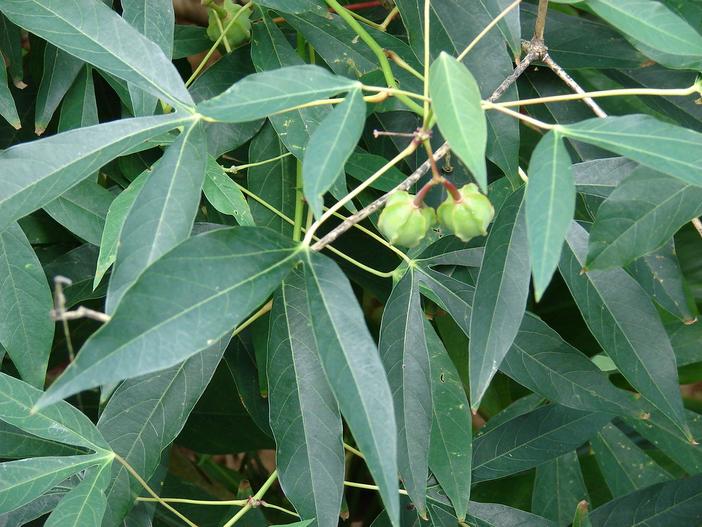Cassava
(Manihot esculenta)
Cassava (Manihot esculenta)
/
/

Forest and Kim Starr
CC BY 2.0
Image By:
Forest and Kim Starr
Recorded By:
Copyright:
CC BY 2.0
Copyright Notice:
Photo by: Forest and Kim Starr | License Type: CC BY 2.0 | License URL: https://creativecommons.org/licenses/by/2.0/ | Uploader: Starr Environmental | Publisher: Flickr













































































Estimated Native Range
Summary
Manihot esculenta, commonly known as cassava, is a perennial woody shrub native to South America, where itthrives in warm, humid environments. It is a staple crop in many parts of the world due to its edible starchy tuberous root, which is a major source of carbohydrates. Cassava typically grows to a height of 1-3 meters (3-10 feet) and features large, palmate leaves that can add a tropical look to gardens. The roots are long and tapered, with a firm flesh encased in a detachable rind. Commercial cultivars vary in size but are generally 5 to 10 centimeters (2 to 4 inches) in diameter and 15 to 30 centimeters (6 to 12 inches) long. Cassava is harvested by hand, which involves raising the lower part of the stem and pulling the roots out of the ground.
Cassava is valued for its drought tolerance and ability to grow in poor soils, making it a reliable crop in challenging conditions. It is often grown in food gardens and as a source of carbohydrates in subsistence farming. The plant requires full sun or part shade, medium water, and well-drained soils. It can tolerate a wide range of temperatures, from as low as 12 °C (54 °F) to as high as 40 °C (104 °F). While it does produce flowers in shades of yellow, green, pink, and white during the winter and spring, they are not particularly showy. Cassava is also known for its potential invasiveness outside its native range, so gardeners should be cautious and check local regulations before planting.CC BY-SA 4.0
Cassava is valued for its drought tolerance and ability to grow in poor soils, making it a reliable crop in challenging conditions. It is often grown in food gardens and as a source of carbohydrates in subsistence farming. The plant requires full sun or part shade, medium water, and well-drained soils. It can tolerate a wide range of temperatures, from as low as 12 °C (54 °F) to as high as 40 °C (104 °F). While it does produce flowers in shades of yellow, green, pink, and white during the winter and spring, they are not particularly showy. Cassava is also known for its potential invasiveness outside its native range, so gardeners should be cautious and check local regulations before planting.CC BY-SA 4.0
Plant Description
- Plant Type: Subshrub, Shrub, Herb
- Height: 6-8 feet
- Width: 6-10 feet
- Growth Rate: Rapid
- Flower Color: Yellow, Green
- Flowering Season: Winter, Spring
- Leaf Retention: Evergreen
Growth Requirements
- Sun: Full Sun, Part Shade
- Water: Medium
- Drainage: Medium, Slow
Common Uses
Border Plant, Drought Tolerant, Edible*Disclaimer: Easyscape's listed plant edibility is for informational use. Always verify the safety and proper identification of any plant before consumption., Rabbit Resistant
Natural Habitat
native to South America, where itthrives in warm, humid environments
Other Names
Common Names: Aipim, Macaxeira, Mandioca, Manioc, Tapioca, Yuca, 樹薯
Scientific Names: , Manihot esculenta, Manihot utilissima, Manihot dulcis, Manihot esculenta subsp. flabellifolia, Manihot flabellifolia, Manihot guyanensis, Manihot esculenta subsp. grandifolia, Jatropha manihot, Manihot manihot
GBIF Accepted Name: Manihot esculenta Crantz